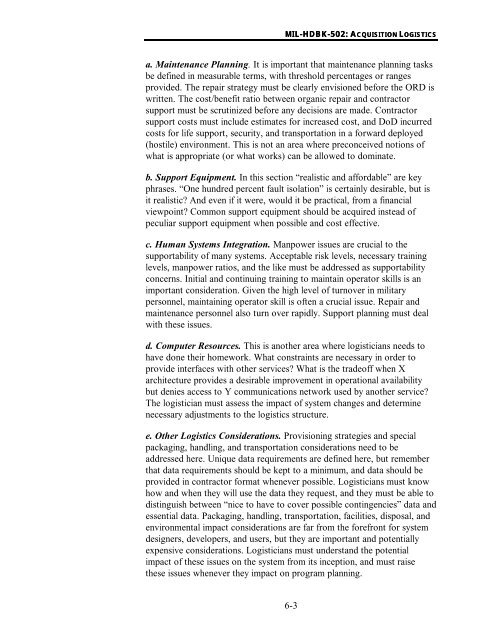MIL-HDBK-502 - Barringer and Associates, Inc.
MIL-HDBK-502 - Barringer and Associates, Inc.
MIL-HDBK-502 - Barringer and Associates, Inc.
You also want an ePaper? Increase the reach of your titles
YUMPU automatically turns print PDFs into web optimized ePapers that Google loves.
<strong>MIL</strong>-<strong>HDBK</strong>-<strong>502</strong>: ACQUISITIONALOGISTICSa. Maintenance Planning. It is important that maintenance planning tasksbe defined in measurable terms, with threshold percentages or rangesprovided. The repair strategy must be clearly envisioned before the ORD iswritten. The cost/benefit ratio between organic repair <strong>and</strong> contractorsupport must be scrutinized before any decisions are made. Contractorsupport costs must include estimates for increased cost, <strong>and</strong> DoD incurredcosts for life support, security, <strong>and</strong> transportation in a forward deployed(hostile) environment. This is not an area where preconceived notions ofwhat is appropriate (or what works) can be allowed to dominate.b. Support Equipment. In this section “realistic <strong>and</strong> affordable” are keyphrases. “One hundred percent fault isolation” is certainly desirable, but isit realistic? And even if it were, would it be practical, from a financialviewpoint? Common support equipment should be acquired instead ofpeculiar support equipment when possible <strong>and</strong> cost effective.c. Human Systems Integration. Manpower issues are crucial to thesupportability of many systems. Acceptable risk levels, necessary traininglevels, manpower ratios, <strong>and</strong> the like must be addressed as supportabilityconcerns. Initial <strong>and</strong> continuing training to maintain operator skills is animportant consideration. Given the high level of turnover in militarypersonnel, maintaining operator skill is often a crucial issue. Repair <strong>and</strong>maintenance personnel also turn over rapidly. Support planning must dealwith these issues.d. Computer Resources. This is another area where logisticians needs tohave done their homework. What constraints are necessary in order toprovide interfaces with other services? What is the tradeoff when Xarchitecture provides a desirable improvement in operational availabilitybut denies access to Y communications network used by another service?The logistician must assess the impact of system changes <strong>and</strong> determinenecessary adjustments to the logistics structure.e. Other Logistics Considerations. Provisioning strategies <strong>and</strong> specialpackaging, h<strong>and</strong>ling, <strong>and</strong> transportation considerations need to beaddressed here. Unique data requirements are defined here, but rememberthat data requirements should be kept to a minimum, <strong>and</strong> data should beprovided in contractor format whenever possible. Logisticians must knowhow <strong>and</strong> when they will use the data they request, <strong>and</strong> they must be able todistinguish between “nice to have to cover possible contingencies” data <strong>and</strong>essential data. Packaging, h<strong>and</strong>ling, transportation, facilities, disposal, <strong>and</strong>environmental impact considerations are far from the forefront for systemdesigners, developers, <strong>and</strong> users, but they are important <strong>and</strong> potentiallyexpensive considerations. Logisticians must underst<strong>and</strong> the potentialimpact of these issues on the system from its inception, <strong>and</strong> must raisethese issues whenever they impact on program planning.6-3
















